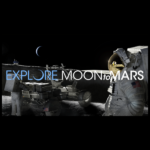NASA Challenge : Moon Movers
Summary Description:
NASA is seeking innovative concepts for the Artemis program to deliver pressurized logistics (food, supplies, water, repair items, tools, etc) to the surface of the moon.
The logistics are housed within pressurized containers that are thermally conditioned while receiving power resources from the lander (used for delivery) until removed. These containers will be offloaded, and used to transfer the logistics to a pressurized rover or be transported across the surface of the moon to their final destination at a surface habitat where they will be loaded by crew/robotics into that habitat through direct pressurized interface connections.
Background:
The Artemis Program is planning to send the humans to the surface of the moon and create a sustained base of operations on the Lunar south pole. A critical component of enabling sustainable scientific exploration on the lunar surface is a robust, repeatable, and reliable lifecycle logistics and supply chain architecture. To better enable this architecture there needs to be standardized, rugged concepts for transporting logistic supplies once they land on the lunar surface. These concepts must be able to withstand the harsh conditions on the surface and be capable of offloading, transport, and pressurized mating with surface vehicles for content transfer. A standard logistics carrier will need to be developed that enables logistics for the extended lunar missions to be delivered to the lunar surface, where they will be transferred from the lander to either a pressurized rover or a surface habitat.
Project/Problem Description:
There is a need for standard logistics containers that can be packed with dry goods on Earth, loaded on a lander, land on the lunar surface, and then transported from a lunarlander to a pressurized, shirt sleeve environment in order to support longer duration crew missions on the lunar surface. Container concept characteristics that should be considered in this challenge include:
1. Sizing: These dry goods, consisting of items such as food, clothing, crew and operational supplies, will be stowed in cargo transfer bags (CTBs) which have dimensions of 50.2 cm X 42.5 cm X 24.8 cm and mass of 0.89kg each. For a 4 crew, 28-day lunar mission it is estimated that there will be a need for 1,365kg of logistics supplies packed in 75 CTBs. Along with the need for CTBs, there is anticipated to be a need to accommodate larger items such as spare parts or those required for outfitting or reconfiguring a shirt sleeved environment that will not fit in CTBs, so it would be referable that the container(s) accommodate different internal configurations or are reconfigurable to accommodate this scenario. Container concepts should consider sizing to minimize total mass of the containers compared to the total mass of the dry goods. Additionally, sizing should consider the complexity of operations related to larger quantities of smaller containers versus smaller quantities of larger containers.
2. Pressure: The containers will need to be initially packed on Earth at 14.7psi and will be required to hold a pressure of at least 8.2psi until the dry goods are removed from them and must have a way to equalize the pressure before being opened in the pressurized environment on the lunar surface.
3. Temperature: The containers will need to maintain an internal temperature between 10 and 30 degrees Celsius until the dry goods are removed from them in order to ensure any sensitive dry goods, such as medicines, do not go outside of acceptable temperature range.
4. Data Logging and Transmission: The containers will need to communicate and/or store data records of temperature and pressure in order to ensure these parameters were within acceptable range since the dry goods were packed.
5. Power: The containers will need to maintain temperature and data records, therefore power will be required, either from the lander or from internal stored energy. Power will be required at least until the crew can retrieve the containers which can be up to 120 days after landing on the lunar surface.
6. Packing/Unpacking: The containers will need to be loaded on Earth and unloaded on the lunar surface. There will be a need to stow the dry goods within the container in a secured and orderly manner in order to minimize any shifting of contents during launch, landing and transport across the lunar surface.
7. Delivery and Handling: The containers will be delivered to the lunar surface on a logistics lander. The containers will need to be offloaded from a logistics lander, preferably in an automated manner, but also potentially manually by the crew. Some of the containers will then be attached or connected to a pressurized rover so that the crew can unload dry goods to be used within the rover. Other containers will be taken to a surface habitat for use by crew within that element. In order to accomplish these transfer operations, any offloading, transfer, and transport concepts must be reliable, minimize crew time required to perform the offloading and transfer, and can be performed safely by the crew.
8. Interfaces: The dry goods in the containers will need to be accessed by the crew, in a pressurized environment, on the lunar surface. Preferably the containers will not need to be brought into the environment in order to unpack them as this would require a crew EVA to retrieve them, cleaning of the exterior of the container to mitigate lunar dust prior to bringing them into the environment, and space inside the environment to store the container if they are brought inside. Therefore, any container concept needs to attach to the pressurized environment in order to allow for loading and unloading by the crew. For this challenge, the container concepts should include a 67 cm x 47 cm hatch in order to allow for the transfer of goods by mating of the container to a shirt sleeve environment, such as a pressurized rover or surface habitat, without having to bring the carrier inside.
9. Support Equipment: Container concepts should identify and detail any support equipment needed in order to be able to pack/unpack, load/offload, and/or transport the containers across the lunar surface.
10. Reusability: Once the containers have been used to deliver the dry goods they will be used to store trash and waste until such time as it can be dealt with or if not needed will be available for other uses. Container concepts could potentially have other functionality for repurposing after they have delivered the cargo.., have a pressure equalization valve and be able to monitor internal pressure and temperature data.
The criteria for evaluation will include examination of the durability, quantity, size, and dimension of the logistics containers, along with power needs vs how long the carrier can maintain temperature range, ease of offloading and handling, human factors involved in packing and unpacking the dry goods into/from inside the carrier, complexity of the concept of operations, and total mass of containers vs the mass of the dry goods carried.
Requirements
Judging Factors
Proposal quality. Clear definition of delivery and container concept. Submission is well-organized and reflects an understanding of the problem statement, operational environment, and constraints. Presentation and analysis easily facilitates the evaluation of concept.
Concept of operations – submission details how the carrier is launched, deployed, and operated as well as the operation of subsystems; presents overall considerations for interoperability with other assets Completeness – submission of all documents with requested content; presentation of overall design and required subsystems needed with accompanying data and drawings Technical credibility – submission documents ground rules and assumptions, design and implementation is feasible in a mission scenario, supporting calculations and analyses are summarized, and design is judged as realistic and effective within the constraints of the challenge Environmental considerations/survivability – submission considers survivability from launch landing and in transfer between assets across the lunar surface; at a high level, submission considers temperature range in operation, dust mitigation, vacuum, and reduced gravity environment Fidelity of the model – submission is of a high fidelity with appropriate design detail; submission is detailed enough to explain the technical solution and evaluate it
1. The competitor shall deliver a report in PDF/MS word format that covers the concept design, pictures/drawings, dimensions, concept of operation, functions/features, mass breakdown, interface requirements/design, and expected resource needs (e.g. power, communications).
2. The competitor shall deliver any CAD or animations used in the development of the concept.
Rules
ENTERING THE COMPETITION:
If you think an entry may infringe on existing copyrighted materials, please email challenges@grabcad.com.
By entering the Challenge you:
1) Accept the official GrabCAD Challenges Terms & Conditions.
2) Agree to be bound by the decisions of the judges (Jury).
3) Warrant that you are eligible to participate.
4) Warrant that the submission is your original work. Warrant, to the best of your knowledge, your work is not, and has not been in production or otherwise previously published or exhibited.
5) Warrant neither the work nor its use infringes the intellectual property rights (whether a patent, utility model, functional design right, aesthetic design right, trademark, copyright or any other intellectual property right) of any other person.
6) Warrant participation shall not constitute employment, assignment or offer of employment or assignment.
7) Are not entitled to any compensation or reimbursement for any costs.
8) Agree the Sponsor and GrabCAD have the right to promote all entries.
Submitting an Entry
Only entries uploaded to GrabCAD through the “Submit entry” button on this Challenge page will be considered an entry. Only public entries are eligible. We encourage teams to use GrabCAD Workbench for developing their entries. Entries are automatically given the tag “NASAMOONMOVERS”; when uploading to GrabCAD. Please do not edit or delete this tag. Only entries with valid tag will participate in the Challenge.
AWARDING THE WINNERS
The sum of the Awards is the total gross amount of the reward. The awarded participant is solely liable for the payment of all taxes, duties, and other similar measures if imposed on the reward pursuant to the legislation of the country of his/her residence, domicile, citizenship, workplace, or any other criterion of similar nature. Only 1 award per person. Prizes may not be transferred or exchanged. All winners will be contacted by the GrabCAD staff to get their contact information and any other information needed to get the prize to them. Payment of cash awards is made through Checks mailed to the Winners. All team awards will be transferred to the member who entered the Challenge. Vouchers will be provided in the form of Stratasys Direct Manufacturing promo codes.
We will release the finalists before the announcement of the winners to give the Community an opportunity to share their favorites in the comments, discuss concerns, and allow time for any testing or analysis by the Jury. The Jury will take the feedback into consideration when picking the winners.
Winning designs will be chosen based on the Rules and Requirements schedule.
In order to be eligible for a prize solutions must originate from either the U.S. or a designated country (see definition of designated country at https://www.acquisition.gov/far/part-25#FAR_25_003), OR have been substantially transformed in the US or designated country prior to delivery pursuant to FAR 25.403(c).
Schedule
This Challenge ends on January 9th, 2023 (23:59 EST.) Finalists will be announced on January 23rd, 2023 and Winners will be announced on February 2nd, 2023
Prizes
$7000 in Prizes
- First Place $3500
- Second Place (x2) $1000
- Third Place (x3) $500
About The Habitation Systems Development Office at NASA
The Habitation Systems Development Office at NASA Marshall Space Flight Center supports systems engineering, integration, and project management for next-generation space habitats. The office is responsible for formulation activities related to Lunar Surface Habitat and Mars Transit Habitat. The Logistics Formulation Team at Kennedy Space Center supports the Architecture Development Office and is responsible for formulating logistics systems supporting Lunar and Mars Surface operations.

NASA Challenge : Moon Movers




